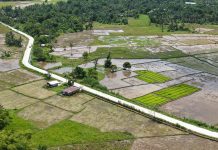TACLOBAN CITY- After supertyphoon ‘Yolanda’ pummeled the Visayas in 2013, Caritas Philippines has launched its “most massive, far-reaching and largest funded” response amounting to P2.6 billion “funding infusion” from all Caritas Internationalis member organizations, benefiting more than 1.8 million Filipinos who were severely affected by the deadly storm.
Jing Rey Henderson, communications and partnership development coordinator of Caritas Philippines/National Secretariat for Social Action, disclosed that they informed the survivors that the program “is not of the Catholic Church or the social action centers.”
The Catholic Church’s humanitarian arm believed that even vastly devastated by the typhoon, the communities and families still have the innate capacity to bounce back and become more empowered, resilient and sustainable, she said.
“Through these, it was ensured that even without the presence of the social action centers, and even beyond the funding period, the communities can sustain the programs and interventions,” Henderson said in an interview.
“And true to our vision, this is what has been happening among all 166 communities under the church’s Yolanda/Haiyan intervention. With how the three-year program intervention was designed, implemented, and now being monitored, the communities were given the center-stage to decide, operate and manage the projects and activities,” she added.
With regards to the housing, Henderson stressed that the designs have already been finalized in collaboration with the beneficiaries reason for the different designs in different locations.
“This is to ensure that the needs and priorities of the homeowners are met, and protection, security, and safety were also provided. We are happy and proud to let you know that these Yolanda/Haiyan houses have been used and identified also as supplemental evacuation centers during typhoon Ruby and the succeeding typhoons affecting the nine provinces,” she added.
All houses have been completed already, Henderson reported.
“And now, the communities (home-owners’ associations) are managing the housing projects, both on-site and in the relocation sites. The home-owners were also trained on the resiliency features of the houses, carpentry, masonry and other skills which they are now using in maintaining the upkeep of their houses and as additional sources of income for their families,” she said.
Caritas Philippines reported that from Calbayog, Capiz, Aklan, Coron, Borongan, Iloilo, Antique, Cebu and Leyte, they have repaired 593 housing units and constructed 768 transitional units, 1, 923 progressive core-shelter units, and 1, 167 permanent shelter units both in on-site and relocation sites with a total amount of P347,287,400.00 to include its labor cost.
On its design, their progressive core house has a lifespan of 10 years, designed to expand and upgraded by beneficiaries, with covered living space in a square meter of a minimum of 12m2 floor space, yet target families will be able to expand within 12 months and with close monitoring and allocation of a contingency fund.
Permanent houses are either built in row houses with a partition for room and toilet facilities or on-site single detached with a partition for two rooms and toilet facilities.
Aside from the housing and relocation site development, Caritas Philippines also provided early interventions from emergency food, hygiene distribution, livelihood support, water facilities construction, hygiene and sanitation promotion, solid waste management, and ecosystems recovery and other environmental protection activities.
(RONALD O.REYES)



